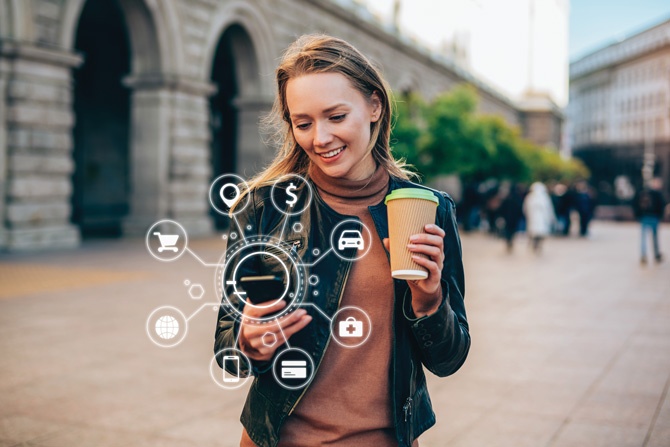The pressure on banks to really step up their digital experience game is, as we all know, greater than ever. Branch banking, according to pundits, is probably going away. “Probably” because, honestly, no one really knows, right? It sure looks like it, however.
That being the case, where does that leave banks? With a huge incentive to ramp up their digital experience through personalization.
Also, according to pundits, most banks are offering only the basics in this channel. And why is that? There is no doubt that personalization is a big deal in customer engagement. Having that deep understanding of each customer’s unique needs, driven by data and analytics and aided by machine learning, is every marketer’s dream. That understanding of exactly what a customer is thinking, feeling and needing forms the very bedrock of any solid, strategic marketing effort.
According to the Boston Consulting Group (BCG), “a majority of people who are either open to or actively mulling changing banks would consider banking with a tech company — such as Amazon, Facebook, or Google — if they could. This is not surprising because such companies have spurred a desire for more customized interactions and fostered a willingness to trade data for a better experience.” BCG goes on to say: “Several consumer brands have shown the way forward. Netflix uses personalization techniques to make movie and series recommendations. Yet while many financial institutions are conceptually on board and heavily investing, the Netflix of banking has yet to emerge. The main reason is that true end-to-end personalization requires developing new muscles — such as strong cross-channel offerings, cross-enterprise collaboration, a single view of the customer, and a new technology ecosystem — all of which are difficult to build.”
Agreed, for the most part. Is receiving a purchase recommendation from Amazon or Netflix the same as getting one from your bank? I’m not convinced. When Netflix tells me that I might be interested in a certain program because it somehow aligns with one I’d watched previously, I have no concerns about data sharing and privacy. The kind of personal data that a bank needs to personalize one’s digital experience is far different from the data that Netflix uses to recommend their latest docuseries.
I think it might have been one of those satirical commercials done by Saturday Night Live a while back; I’m not sure. But what I do remember was their lampooning of banks using personal data for marketing purposes. At one point in the faux commercial, which featured a young couple, the man receives a series of SMS messages from their bank. The messages are fairly innocuous at the start but become progressively more disconcerting. The first text seems ordinary enough: “We hope you’re enjoying the new truck you purchased with one of our auto loans.” When it’s followed shortly afterward by, “We’ve noticed that you made a large purchase at the grocery store just the other day … having a party?” The couple gets a bit concerned. By the last message, they’re totally creeped out: “We have the loan you need when you’re ready to decorate that baby room. Congratulations.” The gag, of course, is that the couple doesn’t know they’re pregnant, yet their bank somehow does.
Granted, this is a bit of hyperbole, but it does point to the fact that monetizing consumer data can pretty quickly run afoul of the consumer’s desire for privacy. Consumers want the convenience of products and services being brought to their attention based on their “buyer journey” and purchasing habits. Still, they’re definitely conflicted about how much of their personal information is needed to make that happen.
A Cognizant (https://www.cognizant.com/whitepapers/putting-the-experience-in-digital-customer-experience-codex1180.pdf) white paper on the subject states when it comes to digital experiences, “critical customer interfaces should be reexamined in an era when Starwood Hotels allows you to check in and open the door to your room with your SmartPhone. Without making sound decisions over the coming months, many may be left struggling to catch up to digital winners.”
Again, can a bank’s digital experience be equated with the ability to open a hotel room door without “hassling” with a key? What if you received a text or email from your bank saying: “Your oldest daughter is nearly 28 years old. Shouldn’t she be getting married soon? Maybe you should consider one of our HELOCs for that reception.” Or, better still, “Is everything okay at home? Over the past two weeks, you’ve spent $187.50 at the liquor store.”
So, are banks “way behind” companies like Netflix and Amazon in offering a personalized experience? I’m not sure that we’re comparing apples to apples here. Yes, banks do need to do a better job of anticipating customer needs and engaging them across all channels with “the right message at the right time,” but it does make sense that they tread lightly here. Research from Epsilon indicates that a substantial percentage of consumers want and expect personalization:
- 90% of consumers feel that personalization is “very/somewhat” appealing.
- 80% of consumers are more likely to do business with a company that offers personalized experiences.
However, the research indicates this as well: “Despite consumers’ growing comfort with (and demand for) personalized interactions, a significant percentage of consumers are still protective of their personal information.” Twenty-five percent of consumers see getting personalized offers as “creepy,” and 32% say that getting personalized experiences is not worth giving up their privacy. More than one-third (36%) feel that companies don’t do enough to protect their private information.
BCG estimates that for every $100 billion in assets that a bank has, it can achieve as much as $300 million in revenue growth by personalizing its customer interactions. Moving forward, the lion’s share of that interaction will be digital. Banks will certainly appreciate the $300 million in revenue growth, but they’re smart to take a thoughtful approach to try to be the next “Netflix bank.” After all, isn’t personalization about listening to, understanding, and responding to the wants and needs of customers? Those who are listening are, in my opinion, being justifiably cautious.
About Bank Marketing Center
Here at BankMarketingCenter.com, our goal is to help you with vital, topical, and compelling communication with customers and messaging to help you build trust, relationships, and revenue. Visit bankmarketingcenter.com, or by phone at 678-528-6688, or email nreynolds@bankmarketingcenter.com.









